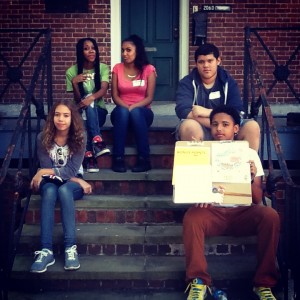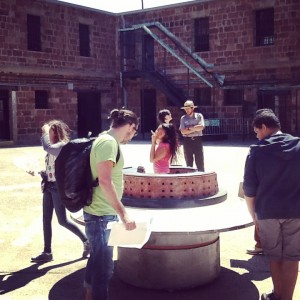Blog Archive
Learning to Read Buildings
We dedicate a lot of time and energy to teaching students how to read books. I’d like to propose we also focus on learning to read buildings. Like books, buildings have stories and are subject to interpretation. Building materials and design carry information. Similarly, their use and contents are evidence of people, events, and change over time. Like learning to read the ABCs, learning to read a building takes practice. It requires skills of looking, thinking, asking questions, and making connections and interpretations.
The Tenement Museum recently partnered with the National Park Service and the Stephen T. Mather Building Arts & Craftsmanship High School to help incoming freshmen kick off their year with an exercise in learning to read buildings. As a new Career and Technical Education high school specializing in the building arts and landscape trades, Mather High School was particularly keen to create a foundation for its students to understand what makes a place matter. Answering this question requires the ability to do a close reading of buildings and got me thinking about how important it is to teach all students how to read and interpret the places around us.
Governor’s Island was selected as an ideal site for students to begin their instruction. Taking a field trip on the very first day the freshman students met their classmates and teachers established new parameters for what their classroom could look like. A Preservation Challenge scavenger hunt was created to introduce students to the material. Armed with maps, resources, a compass, and an iPad, students went off in small teams to take on three missions designed to get them looking and thinking about place.
Learning to read buildings reinforced several lessons worth remembering as we go into a new school year:
The World Is Our Classroom
All around us are opportunities to discover, question, and make connections. Helping students to see the opportunities in their local bodega, museum, and even own homes is key to preparing them to become lifelong learners.
Be Observant
We have a tendency to go go go, but being able to pause and be observant is essential. How often do we pass something by without noticing what is happening right in front of us? The Preservation Challenge was designed to help students be attentive and give them tools for slowing down and observing their surroundings.
Ask Questions
What makes you curious about the place? What else would you like to know? The best kind of learning leads to new questions, which ultimately leads to more learning. Rewarding students for asking questions as much as answering them recognizes the importance of this skill.
Collaborate
You can’t get through life alone. While working in small teams was a challenge for some, it reinforced the different ways people see and approach problems. Being able to work together is an important skill and it takes practice.
– Miriam Bader, Education Director at The Lower East Side Tenement Museum

